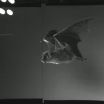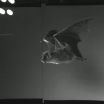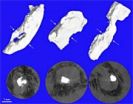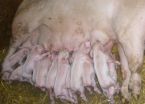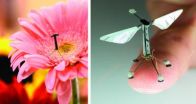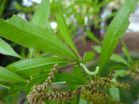(Press-News.org) VIDEO:
As bats fly the air pushes their compliant skin around. A new study provides evidence that they control wing stiffness and shape using muscles embedded in their skin.
Click here for more information.
PROVIDENCE, R.I. [Brown University] — A new study of bats reveals a capability within their wondrous wings that may help them fine-tune their flight.
Bats employ a network of nearly hair-thin muscles embedded in the membrane of their inherently floppy wing skin to adjust the wings' stiffness and curvature while they fly, Brown University researchers report. Birds and insects have stiff wings, but the new evidence suggests bats have evolved this muscular means of preserving or adjusting wing shape.
"Aerodynamic performance depends upon wing shape," said Brown biology graduate student Jorn Cheney, lead author of the newly published paper in Bioinspiration and Biomimetics. "The shape of a membrane wing might initially begin flat but as soon as it starts producing lift it's not going to remain flat because it has to deform in response to that aerodynamic load.
"The shape it adopts could be a terrible one – it could make the animal crash – or it could be beneficial," Cheney said. "But they are not locked into that shape. Because bats have these muscles in their wings, and also bones that can control the general shape as well, they can adopt any number of profiles."
Membrane muscle measurements
Cheney wasn't sure what to make of the tiny muscles, called plagiopatagiales, heading into the experiments reported in the paper. They have been known for more than a century but their function has never been demonstrated.
When Cheney considered the muscle function, he estimated that each individual muscle would be too weak to reshape the wing. That led him to form two competing hypotheses: either that the muscles would activate together to enhance force or that these oddly shaped, weak muscles might exist solely as sensors of stretch.
Only experiments could settle the question, so Cheney attached electrode sensors to a few muscles on the wings of a few Jamaican fruit bats and filmed them as they flew in the lab's wind tunnel.
Three key findings emerged from the data. They all point to the plagiopatagiales modulating skin stiffness.
One result was that the muscle activation and relaxation follows a distinct pattern during flight: They tense on the downstroke and relax on the upstroke.
"This is the first study showing that bats turn these muscles on and off during a typical wingbeat cycle," said co-author Sharon Swartz, professor of biology at Brown.
Another finding was that the muscles don't act individually. Instead they exert their force in synchrony, providing enough collective strength to stiffen the wing.
Finally, Cheney found, the muscles appeared to activate with different timing at different flight speeds. As the bats flew faster, they tensed the muscles sooner in the upstroke-downstroke cycle.
In other words, the data suggested that the muscles do not behave passively but actively and collectively in keeping with conditions of flight.
None of the data, however, preclude the muscles from serving a sensory function as well.
Technological insight, too
Cheney's findings fit into a larger program of research at Brown between the labs of biologist Swartz and co-author Kenneth Breuer, professor of engineering, in which, as Breuer puts it, they are "using biology to inspire engineering and using engineering to inspire biology."
In parallel with studies of real bats, the team has also built a robotic bat wing that incorporates their biological observations. Then they use the wing to generate data from experiments that they could never do with living creatures, such as precisely varying kinematic parameters like wingbeat frequency and amplitude, or the degree of wing folding during flapping.
In a separate paper in the same edition of Bioinspiration and Biomimetics, Swartz, Breuer, and former student Joe Bahlman report on how energy costs and aerodynamic forces changed as they varied several kinematic parameters in the robotic bat wing. They found that to generate a given force, such as lift, each of several parameters requires about the same amount of energy, but that the timing and extent of wing folding varies the ratio between lift and power significantly.
The group is now improving the robotic wing by integrating the new findings about how plagiopatagiales impact wing stiffness and shape.
"When one tries to build an engineered flying vehicle, you want to have control over its aerodynamic properties," Breuer said. "This is one more knob that we have to turn now. To be able to use these membrane wings and be able to control the properties in the way that we suspect bats do, using these muscles, is a great opportunity for biomimetic systems."
The group has a paper in press showing that controlling membrane tension in this way controls aerodynamic properties.
INFORMATION:
In addition to Cheney, Breuer, and Swartz, the paper's other authors are Erika Giblin, Nicolai Konow, and Thomas Roberts at Brown and Kevin Middleton at the University of Missouri.
The Air Force Office of Scientific Research (grants F49620-01-1-0335 and FA9550-12-1-0301) and the National Science Foundation (grant IOS1145549) funded the research.
Tiny muscles help bats fine-tune flight, stiffen wing skin
2014-05-23
ELSE PRESS RELEASES FROM THIS DATE:
NASA sees first tropical depression of Eastern Pacific hurricane season
2014-05-23
One week after the official start of hurricane season in the Eastern Pacific Ocean, the first tropical depression was born hundreds of miles southwest of Mexico. NASA's TRMM satellite and NOAA's GOES-West satellites provided looks inside and outside of the depression's clouds. Hurricane season in the Eastern Pacific began officially on May 15.
On May 21 at 22:59 UTC (6:59 p.m. EDT) the Tropical Rainfall Measuring Mission (TRMM) satellite passed over System 92E, which was what Tropical Depression 1E (TD1E) was called before it organized into a depression. TRMM's Precipitation ...
Supernova caught in the act by palomar transient factory
2014-05-23
Supernovae—stellar explosions—are incredibly energetic, dynamic events. It is easy to imagine that they are uncommon, but the universe is a big place and supernovae are actually fairly routine. The problem with observing supernovae is knowing just when and where one is occurring and being able to point a world-class telescope at it in the hours immediately afterward, when precious data about the supernova's progenitor star is available. Fortunately the intermediate Palomar Transient Factory (iPTF) operated by Caltech scans the sky constantly in search of dramatic astrophysical ...
Mapping atherosclerotic arteries: Combined approach developed
2014-05-23
A new method allows calcified and constricted blood vessels to be visualized with micrometer precision, and can be used to design containers for targeted drug delivery. Within the project "NO-stress", materials scientists from the Medical Faculty of the University of Basel combined cutting-edge-imaging techniques to visualize and quantify the constrictions caused by atherosclerosis.
Cardiovascular diseases, including atherosclerosis, are associated with plaque formation and the most prevalent cause of death worldwide. Unlike vessels and other soft tissues, the plaque ...
Risk is much more than a game
2014-05-23
Wildfires and flooding affect many more people in the USA than earthquakes and landslide and yet the dread, the perceived risk, of the latter two is much greater than for those hazards that are more frequent and cause greater loss of life. Research published in the International Journal of Risk Assessment and Management, suggests that a new paradigm for risk assessment is needed so that mitigation plans in the face of natural disasters can be framed appropriately by policy makers and those in the emergency services.
Maura Knutson (nee Hurley) and Ross Corotis of the University ...
The protective milk shot
2014-05-23
Antibodies against C. suis are transferred via the sow's very first milk to the piglets immediately after birth. This was discovered by veterinarian and parasitologist Lukas Schwarz and his colleagues in 2013. These findings prompted the researchers at the Institute for Parasitology to look for a way to increase the level of these antibodies in sows. The ultimate goal was to provide the piglets with as much antibodies as possible via their mother's milk during the first few days of life.
Piglets from infected mothers are healthier
The idea paid off. Piglets from infected ...
Nature inspires drones of the future
2014-05-23
Researchers have been taking tips from nature to build the next generation of flying robots.
Based on the mechanisms adopted by birds, bats, insects and snakes, 14 distinguished research teams have developed solutions to some of the common problems that drones could be faced with when navigating through an urban environment and performing novel tasks for the benefit of society.
Whether this is avoiding obstacles, picking up and delivering items or improving the take-off and landing on tricky surfaces, it is hoped the solutions can lead to the deployment of drones in ...
Rapid evolution aids spread of exotic plant species
2014-05-23
A team of Belgian biologists led by researchers at KU Leuven has provided the first genetic evidence that rapid evolution can help non-native plant species spread in new environments. Using samples of centuries-old herbaria and DNA analysis, the researchers reconstructed the genetic adaptations undergone by the Pyrenean rocket prior to its rapid spread in Belgium.
The Pyrenean rocket (Sisymbrium austriacum subsp. chrysanthum) is a plant that grows in the mountains of southern Europe and is particularly prevalent in the Pyrenees. The species was first reported in Belgium ...
Lack of plant diversity spurs cankerworm damage in cities
2014-05-23
Research from North Carolina State University finds that a lack of plant diversity is a key contributor to the widespread defoliation caused by cankerworms in cities, and highlights the role that increasing diversity can play in limiting future damage.
Fall cankerworms (Alsophila pometaria) are caterpillars that are native to the eastern United States and hatch in early spring. The cankerworms defoliate trees and other plants, eating new leaves as they emerge – which is both unsightly and can ultimately kill the plants.
"We see cankerworms doing more damage to trees ...
Flatland optics with graphene
2014-05-23
Researchers from CIC nanoGUNE, in collaboration with ICFO and Graphenea, introduce a platform technology based on optical antennas for trapping and controlling light with the one-atom-thick material graphene. The experiments show that the dramatically squeezed graphene-guided light can be focused and bent, following the fundamental principles of conventional optics. The work, published yesterday in Science, opens new opportunities for smaller and faster photonic devices and circuits.
Optical circuits and devices could make signal processing and computing much faster. ...
Bacterial adaptation contributes to pneumococcal threat in sickle cell disease patients
2014-05-23
Researchers have identified differences in the genetic code of pneumococcal bacteria that may explain why it poses such a risk to children with sickle cell disease and why current vaccines don't provide better protection against the infection. St. Jude Children's Research Hospital scientists led the study, which appeared earlier this month in the journal Cell Host & Microbe.
The findings will aid efforts to improve vaccine effectiveness and inform research into new ways to protect young sickle cell disease patients from life-threatening pneumococcal infections that can ...
